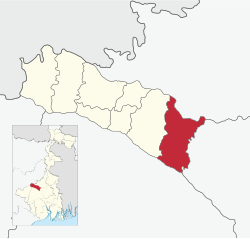Population
As per the 2011 Census of India Kanksa CD Block had a total population of 178,125, of which 103,594 were rural and 74,531 were urban. There were 91,350 (51%) males and 86,775 (49%) females. Population below 6 years was 20,210. Scheduled Castes numbered 62,239 (34.99%) and Scheduled Tribes numbered 18,239 (10.24%). [8]
As per 2001 census, Kanksa block had a total population of 151,255, out of which 78,669 were males and 72,586 were females. Kanksa block registered a population growth of 17.71 per cent during the 1991-2001 decade. Decadal growth for Bardhaman district was 14.36 per cent. [9] Decadal growth in West Bengal was 17.84 per cent. [10] Scheduled castes at 59,956 formed around one-third the population. Scheduled tribes numbered 15,290. [11]
Census Towns in Kanksa CD Block are (2011 census figures in brackets): Arra (7,808), Gopalpur (15,967), Bamunara (6,665), Amlajora (5,856), Kanksa (23,789), Debipur (9,967) and Prayagpur (4,479). [8]
Large villages (with 4,000+ population) in Kanksa CD Block are (2011 census figures in brackets): Basudha (5,166), Ijjatganj (4,085) and Panagarh (5,510), [8]
Other villages in Kanksa CD Block included (2011census figures in brackets): Bidbihar (206), Bankati (1,255), Malandighi (2,590), Banskopa (2,711), Tilakchandrapur (1,970), Gourangapur (110) and Sibpur (1953). [8]
Literacy
As per the 2011 census the total number of literates in Kanksa CD Block was 120,545 (76.34% of the population over 6 years) out of which males numbered 67,797 (82.05% of the male population over 6 years) and females numbered 52,748 (68.62% of the female population over 6 years). The gender disparity (the difference between female and male literacy rates) was 15.03%. [8]
As per 2001 census, Kanksa block had a total literacy of 68.05 per cent for the 6+ age group. While male literacy was 78.24 per cent female literacy was 56.96 per cent. Bardhaman district had a total literacy of 70.18 per cent, male literacy being 78.63 per cent and female literacy being 60.95 per cent. [12]
See also – List of West Bengal districts ranked by literacy rate
Language and religion
| Religion in Kanksa CD block (2011) [13] |
|---|
| | |
| Hinduism | | 91.61% |
| Islam | | 6.82% |
| Other (tribal religion) | | 0.52% |
| Other or not stated | | 1.05% |
In the 2011 census Hindus numbered 163,186 and formed 91.61% of the population in Kanksa CD Block. Muslims numbered 12,157 and formed 6.82% of the population. Christians numbered 386 and formed 0.22% of the population. Others numbered 2,396 and formed 1.35% of the population. [13]
At the time of the 2011 census, 79.68% of the population spoke Bengali, 9.95% Hindi, and 9.18% Santali as their first language. [14]


